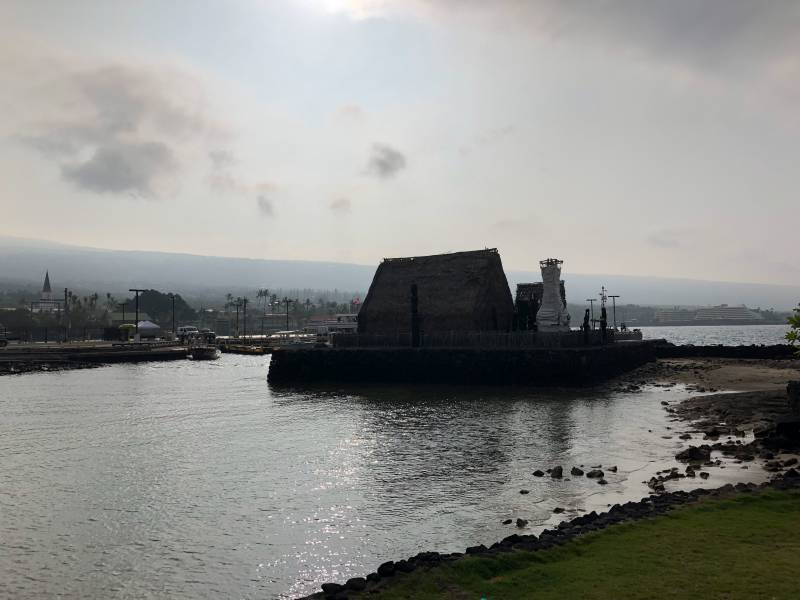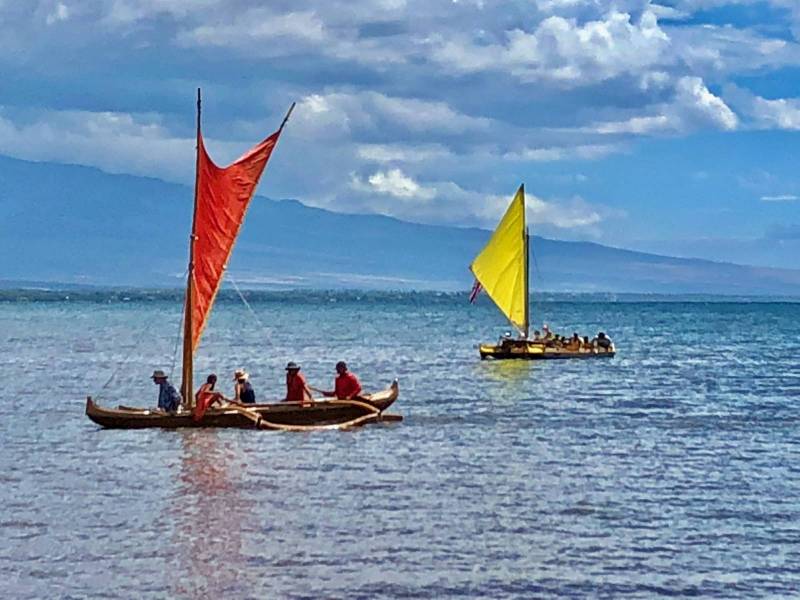I almost titled this blog post, “Did you know Waikiki is in Kona?” Itʻs true. Waikiki is in Kona. So are Lahaina, Kapalua, Kihei and Wailua on Maui. Of course, if you are flying to Hawaiʻi and choose “Kona” airport as your destination, you will not land on Oahu or Maui; you will land at Keahole on Hawaii Island. Which is also in Kona. But if you land at Honolulu airport, you also land in Kona.
Kailua on Hawaiʻi Island is, according to the post office, Kailua-Kona. Thatʻs because Kailua on Oahu is not in Kona, even though Waikiki and Honolulu are.
Confused yet?

About to land on the Kona side of Oʻahu…looking at Honolulu, Waikiki and the profile of Leahi (“Diamond Head”)
Place Names in Hawaiʻi – The Hawaiian Language Has Meaning
This blog post started with an email to me from a Hawaii Island resident, Caroline “C.C.” Greenwell, saying she enjoys watching our Hawaii Life show on HGTV, but is bothered when the agents, buyers or editorial of the show use incorrect place names. She emailed the right person, as it bothers me too. But it is not surprising that this happens on the show. It happens every day in real life.
In casual daily conversation most of us here, even those of us who know better, might say we are “driving to Kona today” when what we really mean to say is that we are driving to someplace in the postal code 96740 or Kailua Kona…and might actually be going to Holualoa or Keauhou, which are in “Kona” but not in Kailua. And whatʻs more, since I live on the West side of the island though in a different zip code, I am not in the town of Kailua Kona, nor in the district of North or South Kona, but I live “kona” so it makes no sense for me to be driving to kona.
Hereʻs the thing though. If I were a fluent speaker of the Hawaiian language though, none of this would be confusing. The word “kona” used in this context means “leeward” or on the side sheltered from the wind.
This is an important distinction for you to know if you are considering buying or moving to Hawaiʻi. Our prevailing trade winds come from the northeast. That makes the west and south of each island tend to be drier and sunnier; the east and north of each island has more rain.
Are you looking for luxury resorts and hotels? Leeward = sunny = Kona. Is your preference waterfalls, agriculture, that “tropical jungle” feel? Windward = green = Koʻolau.

Kamahahonu National Historic Landmark photographed from the grounds of the King Kamehameha hotel in Kailua Kona
In other words, traditional place names in the Hawaiian language are not just quaint curiosities. They have meaning in a living language, and provide context and story to that place. And that context and story might matter to you in a practical way.
Why Understanding and Using Correct Place Names in Hawaiʻi Matters
Beyond the practical, if you are someone who is planning to move to Hawaiʻi, or who has already bought a home or condo here, I am imagining that something about this place touched you in a particular way. When I talk about our Conservation and Legacy Lands initiative, I often say that the name of the brokerage (and the HGTV show that prompted the email to me) is Hawaiʻi Life not Generic Island Life. One of the most basic ways to preserve and protect that which makes Hawaiʻi recognizably Hawaiʻi, is by knowing and using proper place names.
Although I have lived on this island for 15 years, I consider myself a malihini or newcomer. On the other hand, my gracious correspondent carries a name that on Hawaii Island would be recognized as an old kamaʻaina family name. When I think about how to most respectfully adopt my island home, I am happy to take advice from someone who though not of native Hawaiian descent, has family roots that reach back to those who chose to make their home in the Hawaiian kingdom four generations ago.
Ms. Greenwell wrote to me: “I believe that our history and culture are carried on through our place names and that we have a responsibility to, in the best of our ability, be as accurate as possible with the proper use of those names. This is especially true when you are in a public forum and perhaps are in a position to educate or influence others. If we don’t adhere to the proper place names it’s possible that they will be lost and with them the history of the area.”

Keeping culture alive: outrigger canoes at the annual cultural festival at Puʻukoholā Heiau National Historic Site in Kawaihae
As Hawaiʻi looks to recover from the economic effects of the Covid-19 pandemic, the future of tourism and development on the islands is inclining in the direction of a regenerative visitor economy, one that gives as well as takes from this place and its people. Wonʻt you join me in being a hoa kamaʻaina, a familiar friend, who also takes on kuleana or responsibility for Hawaiʻi as a place and culture?


Lisa Pegg
June 29, 2020
Mahalo nui for this very illuminating post! Just yesterday, I saved some information about what “leeward” means, to help me remember which side of the island I live on. Now, I have an even easier way to remember: kona = leeward!
Keola Childs
October 20, 2022
Helpful background information! As merely a layperson, which no credentials as to language, cultural histories or anthropology, I am nonetheless about to advance a hypothesis (I’d love to say “theory” but I don’t have documentation to back this up at this point and probably never will) that “Kona” is a many-centuries, gradually “corruption” of “Tonga” and “Ko`olau” is a similar linguistic “corruption” of “Tokelau.” This makes immediate intuitive sense if one postulates that the earlier substantial and influential settlers of these major islands were from or were at that time dominated by those emigrated from Samoa. Just as we Kona kama`aina today often identify the southerly direction as “Ka’u side” or “Kohala side,” it’s likely prehistoric cultures in these islands did the similar thing; look on a map of the central Pacific Ocean, and you’ll see that Tonga lays to the south of the main Samoan islands, and the Tokelau islands lay due north. On all the major islands with Kona districts (all lost in use except for here on the Island of Hawaii), these districts face(d) south or south-southwest with our island’s “Kona” facing mainly west, all in the approximate direction of Tonga; the same applies to north-facing Ko`olau districts on all these major islands, facing the direction of where the Tokelau islands were for Samoan immigrants. With dialectic variations in various consonants, such as we see in Hawaiian words like “Kahiki” for “Tahiti” and “pua`a” for “puaka” (pig) used in southern polynesia, it’s a very short linguistic “drift” from “Tokelau” to “Kokelau” to “Ko`olau.” The oldest living Kona natives I hear pronounce the name of this district not as “Ko’-nah” but with a hanging twist on the “n”, similar but not nearly as strong as New Yorkers saying “Longggisland” for “Long Island”. So from these disappearing elders here, I hear “Konna” with a stall on the “n” made by saying “n” with one’s tongue to the roof of the mouth. It’s a short linguistic path from Tonga (with the “o” being “oh” and not “ah”) to the sound “Konnah” that the missionary “alphabet creators” didn’t perceive or see fit to give an extra letter for that sound as was done with, say, the Maori language, where “ng” is kept in common use/spelling. So, I believe Samoa-originated people, and their subjects emigrated from other nearby islands, would have found it natural to identify locations on the major islands (and even Molokai, where almost the entire island was “Kona”!) as either on the Tonga/Kona side or the Tokelau/Ko`olau side, and they likely did in Samoa. This practice would have been embedded in the language here before the Tahitians arrived with their own referencing linguistics, of which I have not studied.
So, just a personal hypothesis I felt like sharing with you based on your helpful identification of the historical use of “kona,” but one I believe merits study by linguists and perhaps anthropologists. I really don’t think “kona” meant “leeward;” I believe that the Tonga sides of the islands just happened to be leeward sides from the tradewinds of the North Pacific (Samoa being in the South Pacific and not subject to northeast tradewinds that we have here). Thanks again for opening the door to mentioning this. 🙂